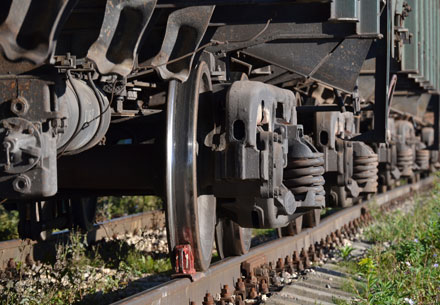The rail industry is one of the main drivers of the economy. People and businesses rely on this mode of transportation to travel and move products of all sizes. As a result, the global rail market continues to make significant investments in efficiency and capacity with a focus on improving passenger experience and transportation of goods.
One of the items that the rail and locomotive industry relies on is forged components. You can find forged parts globally in several rail, track, locomotive, and electrification applications.

The Rail Forging Process
Forging is a process of shaping, deforming, compressing, and manipulating metal to achieve a desired appearance or configuration. Depending on the requirements of the design and the metal type, manufacturers can use hot or cold forging processes.
The first step in forging is choosing a metal, which also determines the forging process. Common metals used include aluminum, carbon, copper, brass, stainless steel, cobalt, titanium, nickel, molybdenum, and alloy metals. Heavier metals go through heat treatment while softer metals like copper, aluminum, and brass are cold-forged.
Once the metal is selected and cut to size, it is heated to the proper temperature for forming. Depending on the forging method, the metal may be inserted into a mold and compressed or pressed between two dies. If cold forging is used, the operator will leave the workpiece at room temperature and work it manually. Once forged, rail components may require secondary finishing processes, such as trimming.
Forging Applications for the Railroad Industry
The many benefits of forging make it an excellent process for producing various parts and components for railroad engines, rail cars, and box cars. Specific rail and locomotive applications for forging include:
-
- Ball Joints. Manufacturers use forging to achieve different ball joint shapes that suit various rail industry applications.
- Cams. Forging ensures that manufacturers meet customer requirements when manufacturing cams used in rail and locomotive equipment.
- Caps. Forging offers an excellent way to create caps used in the rail industry.
- Clutches. The heating processes during forging allow manufacturers to come up with the correct clutch tooth shapes.
- Discs. Disc forging allows for the production of large steel discs for valves used in rail applications.
- Flanges. Forging helps to strengthen flanges used to guide the movement of parts.
- Gears. Gear design requires simple to complex configurations, and forging helps enhance the fatigue properties in steel to ease the designing process.
- Nuts. Hot forging is used to create nuts used in numerous fastening applications in the rail industry.
- Valves. By manufacturing valves through forging, you eliminate possible issues like cracks, porosity, and shrinkage.
- Hand Brake Components. Forging is ideal for safety components, such as pinions, draft gears, levers, and cams, to name a few.
Other rail components that can be produced through forging include pins, rod ends, shafts, spindles, sprockets, yokes, and many more.
Alloy Forging Services at Cornell Forge
At Cornell Forge, we have extensive experience in the forging industry, so you can trust us to deliver reliable rail and locomotive components. We can accommodate forging stainless steel up to 30 lbs and alloy steel and carbon of up to 100 lbs. We also deliver design and tooling services, including optimal forging design, metallurgical consulting, and more. Our value-added services include machining, painting, hardness testing, heat treating, sawing, shot blast cleaning, Magnaflux inspection, assembly, and plating. Contact us for more details or request a quote to get started.



